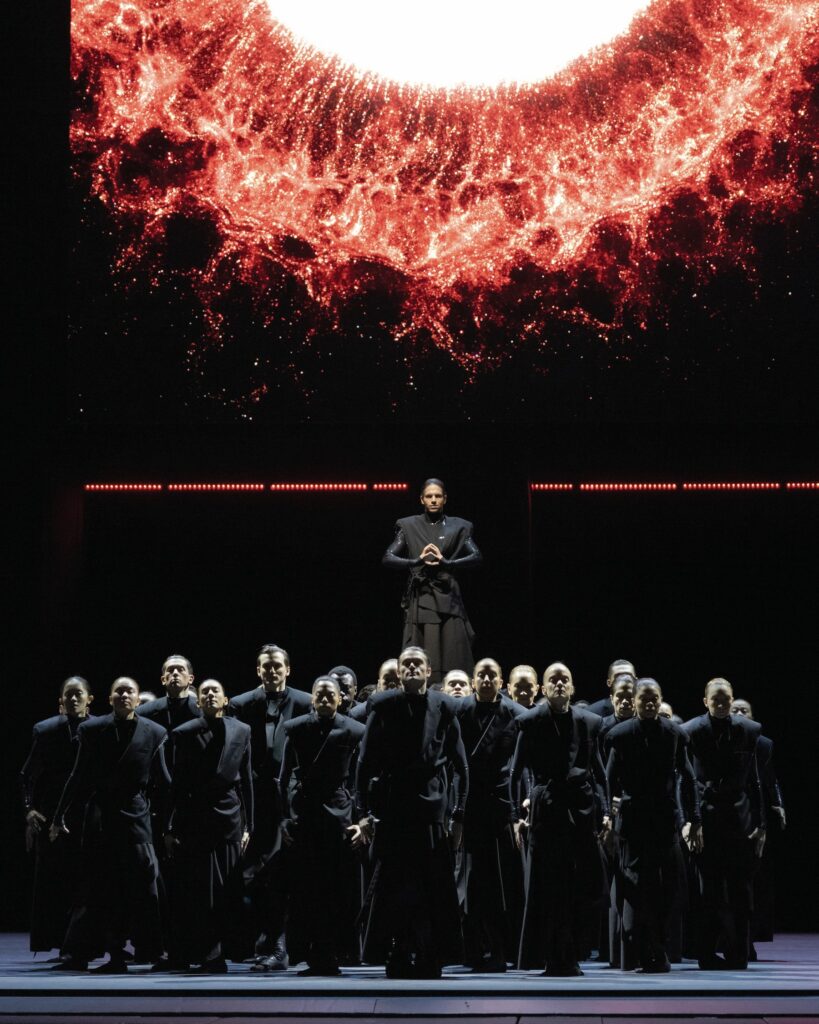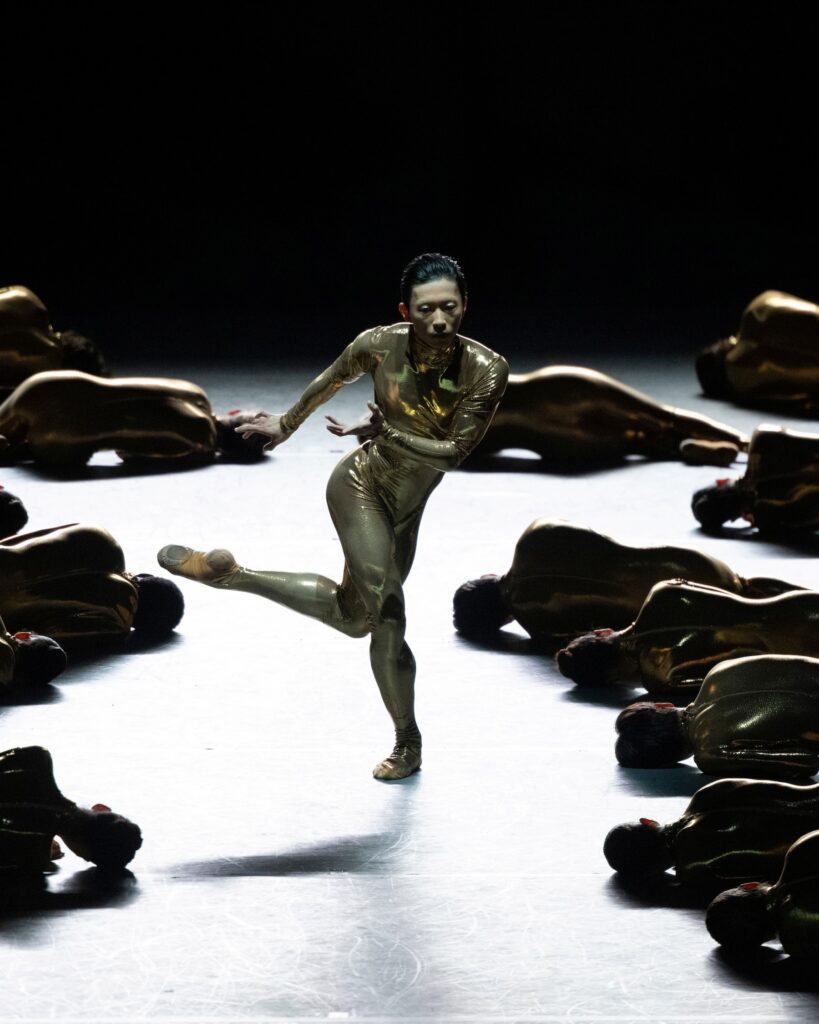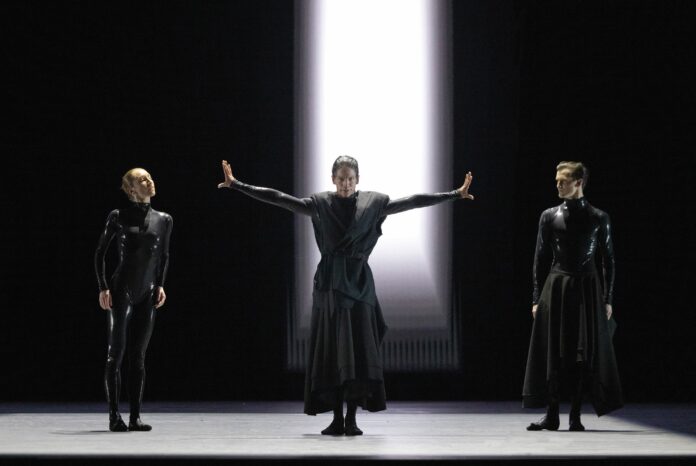We’re going double on Mere Mortals: Read 48 Hills arts editor Marke B.’s review here.
Having reached my mid-40s, I’ve officially crossed the threshold over into “old” territory. As such, I’m not always up-to-date on the latest slang and youthful bon mots. (Which is extra-tough in the Bay Area, where we’ve created enough slang to fill volumes.) I bring this up because I’m genuinely curious: do the young’uns still use the term “make noise” as a euphemism for garnering attention? The first production of SF Ballet’s 2024 season makes a lot of noise; so much so that it’s quite an ordeal, even for someone who doesn’t have audio-visual sensitivities.
Mere Mortals (world premiere through Thu/1 at the War Memorial Opera House, SF) is said to be loosely based on the myth of Pandora, who opened a jar so terrifying it may as well have been a Lament Configuration. This new production by choreographer Azure Barton (music by Floating Points) says that it’s replaced the supernatural maladies of Greek myth with the very-real danger of AI. This is certainly the time and place for such a story: the past year has seen SF the center of yet another gold rush, this time for AI start-ups; and this is an election year, one that’s already seen AI malpractice influence voters. So, yeah, it makes sense for the piece to debut in the city where robot cars will drag you several blocks before someone stops them by putting a traffic cone on the hood.
One enters the War Memorial—something I haven’t done in over a year—to find it awash in red light, as if we were about to see the Emerald City sequence from the film version of The Wiz (coincidentally playing down the road). Barely audible is a droning noise that will increase as the first curtain nears. The first thing we see in the show proper is a solitary figure moving with grace and fluidity through Barton’s choreography as the score begins to resemble the “white room” sequence from 2001: A Space Odyssey. The music seems contrapuntal to the movement, if not specifically the scenery.

That will be the recurring trait of the ballet: fantastic choreography accented by production designer Hamill Industries’ hypnotic onscreen visuals married to an ear-splitting cacophony of noise and seizure-inducing lights. Those visuals (as well as those of the promotional materials) range from celestial explosions you’d love to see as screensavers to the standard AI-punchline images of six-fingered humanoids. I’d love to tell you exactly what this has to do with the AI-Pandora parallels, but I’m honestly not certain? The creators are so eager to overwhelm the senses that any point they’re trying to make is literally drowned out by the production itself. I grew up loving punk music, but this is a lot. (It should be noted that the advisory for the show does warn of the flashing lights.)
Granted, the hour-and-fifteen-minutes of stage time is filled with breathtaking sights, when you don’t need to turn your eyes away for fear of burned retinas. The costumes by Michelle Jank are particularly stunning, ranging from groups muted half-robes showing a frightening conformity, as well as form-fitting gold bodysuits that define the final scenes of the show. Similarly, Barton’s choreography is somehow always kinetic, even when the characters are standing still. The silhouette of Pandora (Jennifer Stahl) against the glowing screen is memorable, yet it hardly holds a candle to the sight of her falling to the ground and trying to get back up like a sentient marionette.
It’s a tribute to the skill of those assembled, but it’s all too much. The production proves oppressive to both the dancers and the audience. If the point is that AI will have you looking for dark glasses and earplugs, then mission: accomplished. Otherwise, the ballet comes as a mash of various sources to form something recognizable, yet uncomfortable in its incorrect details. Come to think of it, that’s sounds like the description of an AI image, doesn’t it?

As much as I love SF Ballet, I’d stopped going to see them in late-2022 when the War Memorial became a “mask-optional” venue. This is fine for the SF Opera because they livestream their performances, but SF Ballet has declined to do that. Hopefully, they’ll change their minds soon. Still, I need to review shows to get paid, so—wearing a tight KN95 mask and my protective glasses—I once again let capitalism put me amongst the bejeweled ballet elite. From my view, I’d say about 1/5 of patrons and staff were masked, some of the patrons only putting on masks before the show started. I’m pleased to say that the War Memorial’s HVAC system is as impressive as I remember, with the CO² readings of my Aranet4 never going above 881ppm, and that’s with a packed house.
I wasn’t entirely comfortable being back around so many unmasked faces, but I was glad to return to the Opera House. Various lobby devices including a wall of horizontal lights and a smoke-based projection display, added to the theme of the show. The production itself is felled by “nothing exceeds like excess” ethos that’s so eager to do what it can that it does far more than it actually needs. The steps are brought to life by a brilliant ensemble and the costumes have to be seen in-person, but those two analogue elements are muted by the migraine-inducing digital onslaught.
MERE MORTALS’ world premiere runs through Thu/1 at the War Memorial Opera House, SF. info here.






